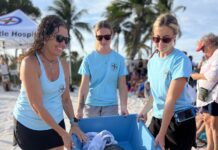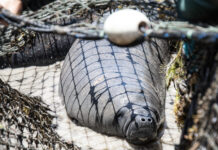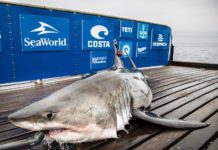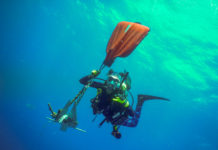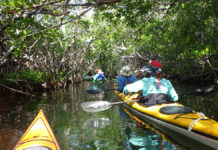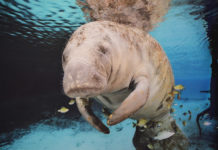
And it ain’t over yet: worm hatch coming soon to an ocean near you
It’s been a good month for the ladies. Big girls, clad in silver scales, are cruising transparent warm ocean waters attended by their ardent, smaller suitors. Some dancing is going on too: a string of green backed tarpon will start circling in an ancient ritual flats anglers call a daisy chain. Even closer to home, my spouse Jeannette Chiari (the lone female participant in an otherwise all male gathering – the 20th annual Tarpon Camp) landed a 125-pound fly rod poon on day one that withstood all male-caught challengers over the following week. As I said, a good month for the ladies.
The annual tarpon migration is in full swing with the advent of fine weather making the fish willing to bite flies, crabs, and mullet. An unusual early low pressure system brought lots of clouds and black squall lines at the very beginning of the month followed by a couple of days of stiff northwest winds. It looked more like January than springtime and made the poons grumpy. But that passed with patient anglers now reaping the rewards.
By mid-May bridges from Channel Two to Bahia Honda were rocked up with tarpon. Tidal changes, especially on the full and new moons, prompted the fish to come out and cruise the Oceanside from bridge to bridge. Most Upper and Middle Keys tarpon are swimming south or west but there are always enough “wrong wayers” (i.e., north or east bounders) to keep fishermen and guides on the alert. This pattern should hold until June when more and more tarpon will reverse course and start departing the Keys. In the Lower Keys, the fish seem to trade between Bahia Honda and Key West.
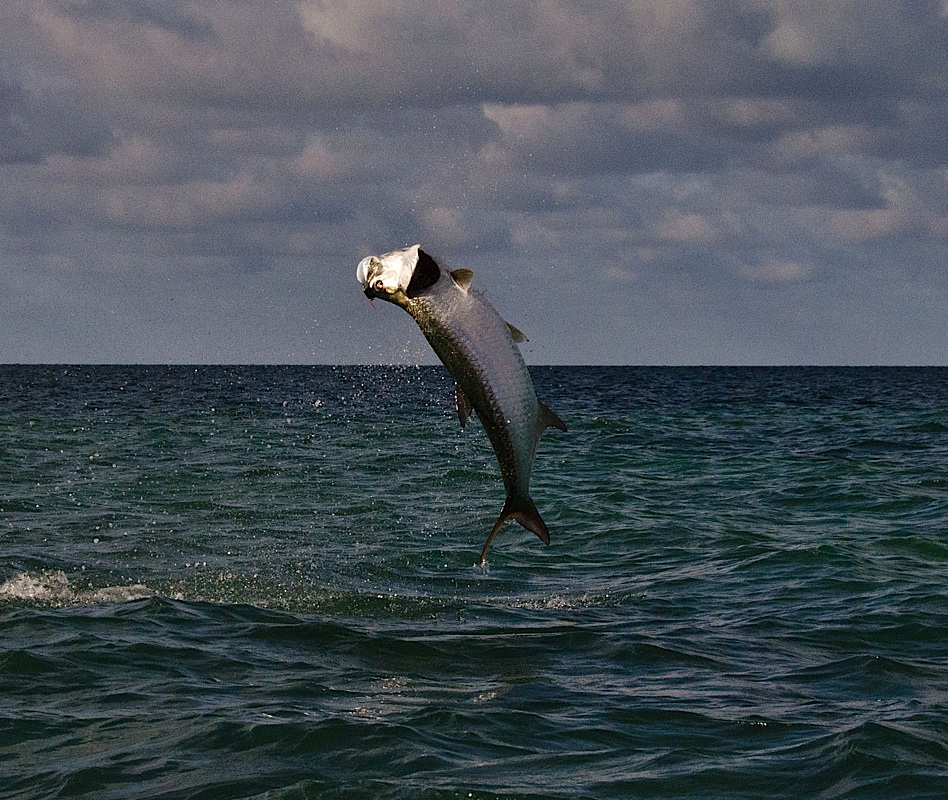
Observant tarpon chasers hope to find “happy” brown-backed tarpon oozing toward their skiffs. Happy fish move slowly and frequently roll. Fish high in the water column appear brownish; these are the ones more willing to bite compared to fast moving deep tarpon that often show turquoise tints. My friends refer to these unwilling poons as “catfish.”
For the next few weeks, the big migrants make the Keys the center of the saltwater flyrodders’ universe. Many are new to this demanding game and learn quickly that everything has to go right to catch a big tarpon on a long limber rod, 16- or 20-pound test leader, and an artificial fly concocted of feathers, fur, and hair to mimic a shrimp, crab, or pilchard. When the fish, looking like submarines, cruise into view (and casting range), the angler must clamp down on jangling adrenalin-fed nerves, cast long and accurately through the wind, entice the fish to eat the fly, stick the hook into a big bony mouth (but don’t yank too hard to avoid breaking the leader), clear the hissing snakelike fly line onto the reel, survive the explosive gill rattling leaps, and prevail in a protracted tug of war with a power packed fish.
Obsession comes with this challenge and exhilaration – think Captain Ahab and Moby Dick. And there is a Great White Tarpon out there to be pursued. Three years ago Capt. Bus Bergmann and I saw a rare albino tarpon – the golden color of sargassum weed – swim by us at Long Key. Moby Tarpon reappeared three weeks ago off Marathon cruising past Capts. Richard Keating and Albert Ponzoa.
On May 7-9, Marathon hosted the 47th Annual Marathon International Tarpon Tournament with teams fishing the bridges. Capt. James Platt guided his team to top honors with Capt. Kevin Goodwin’s boat coming in second.
Our annual tarpon run is also a social event. Lots of friends visit once a year to chase the fish, catch up with their Keys’ pals, and party (and tell lies). We host a Tarpon Camp party every year with an eclectic collection of our Marathon friends, visitors from as far away as Alaska, and this year a special guest: Keys fishing legend Stu Apte. Stu was one of the pioneers on the flats and held world records for light tackle tarpon, permit, sailfish, and dolphin; his fly rod records for sails and dolphin still stand after 45 years. The drive that made him a Navy fighter pilot and crack angler is still there and he wrote recently a fascinating autobiography entitled “Of Winds and Tides.”
Looking ahead, inshore anglers are hearing a soft chant – the worms are coming, the worms are coming. The palolo worms to be precise. Royal poincianas are starting to show their flaming orange blooms signaling that the worm hatches are right around the corner. More on these wiggling, swimming three inch red worms that drive tarpon beserk in next month’s column.
Marathon resident Bill Horn is a veteran Keys’ flats angler, a former Assistant Secretary of the Interior for Fish, Wildlife, and Parks under President Reagan, and author of “Seasons on the Flats: An Angler’s Year in the Florida Keys.” For more information see his website www.seasonsontheflats.com or contact him at bhorn@seasonsontheflats.com.

















